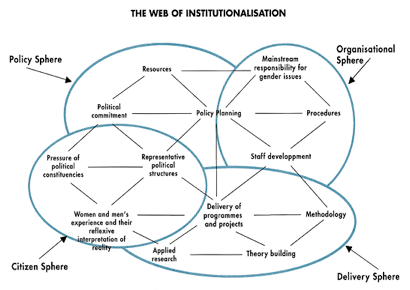II. Methodology
16. In light of the above, the Secretariat of the Convention on Biological Diversity in collaboration with the Senior Gender Advisor at IUCN engaged in the development of the CBD Gender Plan of Action.
17. The CBD Gender Plan of Action is the result of a series of inputs. It has been drafted on the basis of: an analysis of the current performance of the Convention on Biological Diversity in the area of gender and biodiversity; a survey conducted among staff of the Convention on Biological Diversity; and a workshop with staff from divisions within the Secretariat and with the participation from resource persons from UNEP, Women in Environment and Development Organization (WEDO), The Global Environment Facility Small Grants Programme (GEF SGP), and the United Nation development Programme, from 16 to 18 January 2008 in Geneva.
18. The CBD Gender Plan of Action is also based on a review of the implementation of plans of action of similar institutions and international partners, including UNEP, the Food and Agriculture Organization of the United Nations (FAO), the International Labour Organization (ILO), the United Nations Development Fund for Women (UNIFEM), UNDP, the World Conservation Union (IUCN), the Norwegian Agency for Development Cooperation, the Swedish International Development Cooperation Agency, and the Swiss Agency for Development and Cooperation.
19. This Plan of Action defines the role that the Secretariat will play in stimulating and facilitating efforts, both in-house and with partners at the national, regional and global levels, to overcome constraints and take advantage of opportunities to promote gender equality.
20. The Plan is the Secretariat’s and the Convention’s continuing response to global commitments of the last decades as well as recommendations from international fora, and in compliance with major mandates within the United Nations system. It is also a reflection of the increasing awareness that gender equality and women’s empowerment are important prerequisites for environmental conservation biodiversity and sustainable development.
21. A presentation of the plan was made to delegates to the sixth meeting of the Working group on access and benefit sharing (WGABS 6) at a side-event. The final CBD Gender Plan of Action will be submitted to the Conference of the Parties at its ninth meeting, as an information document in Bonn.
“Web of institutionalization”
22. The Plan of Action follows the model of the “web of institutionalization” developed by Caren Levy
1/. Levy proposed that the conditions under which gender can be institutionalized are represented by at least thirteen elements, each representing a site of power. Given the power relations underlying these elements, both opportunities and resistance may arise when change and transformation take place.
23. These elements are not merely a list of variables or entry points. They form a web in the sense that they are linked and interrelated in a particular way and ultimately reinforce each other. Sustained institutionalization of gender issues requires the coexistence of all of the elements. Putting into place only one or a group of elements will almost certainly be insufficient to sustain gender equality as a regular part of development practice in the long term. Moreover, in order to mobilize equality, each element has particular techniques and actions associated with it.
24. These elements are put into place, operated and shaped by different agents or groups of people in a range of interrelated spheres of activity. These spheres are: policy, organizational, citizen and delivery. Given the specific characteristics of the Convention on Biological Diversity, the “citizen” sphere will here be referred to as the “constituency” sphere.
25. The critical point is that an individual may only be able to influence some of the elements, depending on his or her role, position and power to influence change at a particular point in the web. Putting all the elements in the web in place requires collective action through cooperation, consultation, negotiation and conflict resolution between relevant actors at different levels (local, national and international).
